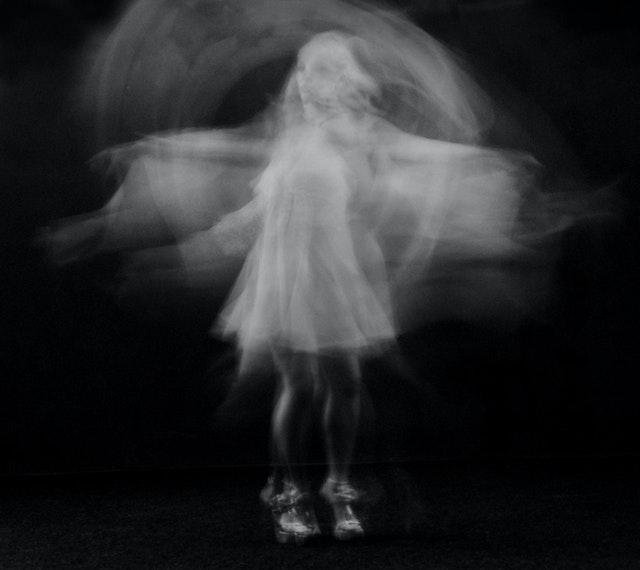I once watched a woman perform a 5- minute-long aria after her character had been left for dead and shoved into a trunk. Nothing about opera is average or realistic. It’s a hyper stylized, outrageous, and loud genre where subtlety is purposefully avoided. Opera films are no different, particularly movies like The Tales of Hoffmann, perhaps the most iconic and well-crafted opera film. I would not call it well-known however, which is a true shame. The film is based off of Jacques Offenbach’s 19th century opera, which in turn, was based off of E.T.A’s story “Sandman”, arguably the first text to feature a female automaton. The opera changes many of the disturbing elements from “Sandman”, like plucking out eyes, but maintains its bizarre atmosphere and even intensifies its fantasy environment.
I want to focus on the Olympia ballet sequence, which is arguably the most famous scene in the film. For context, Hoffman meets an inventor who tries to trick him into marrying his ‘daughter’, a beautiful automaton. While the inventor distracts Hoffman, his assistant winds up Olympia to perform “Les Oiseaux Dans La Charmille”, better known as the very famous Doll Song. Olympia’s singing and dancing are astonishing, as she effortlessly leaps past the other puppets in the scene. However, during her dance, she occasionally breaks down and needs to be wound up again, moments which are actually written into her solo. She occasionally pauses and repeats the same note a few times before collapsing, essentially glitching mid performance.
The scene is especially entertaining because it satirizes the aria tradition and plays with the concepts of femininity and ownership. Olympia’s love song is beautiful but also completely insincere and artificial. As such, the scene indirectly involves discussions about technology, consciousness, and the female body, or the politics around automatons.
For those unfamiliar, an automaton is a living doll, one which has been programmed to behave a certain way and to use a specific script. A modern example would be the hosts in HBO’s Westworld, a show dedicated to exploring the difficult issues automatons inherently pose. Automatons frequently appeared in Victorian literature because they dramatized many of the social commentaries and concerns around both science and gender. They sort of coincided with the era’s rapidly changing understanding of the world, and they became a way to examine social issues in an indirect way. Most of these stories were interested with the automaton’s ability to blend in with other women and humans, a trend which continues today in films like Ex Machina. It would seem that we are still afraid of science and women, and that automatons are the greatest example of this anxiety.
Automatons can be split into two overlapping types: the posthuman and the Venus. A posthuman is a being or form which looks like us, but also surpasses us. This is your typical Frankenstein’s Creature, demonstrating the weird binary between us and something else. What its funny is that the posthuman and Venus actually blend together, as the automaton is often revealed because they are too perfect, too inhuman. What differs between these categories is that the posthuman is generally more violent and sinister, while the Venus is more objectified.
Making women into Venuses is not something new, it is a long-standing artistic tradition and frankly, a suppressive kind. There are countless nude Venus portraits, and the trend is indicative of the way women are treated in society. Venus is an artistic excuse. Saying that your nude portrait is of Venus makes it more appropriate. While a naked portrait of a random woman is a scandal, because what kind of woman takes off her clothes to be in a portrait, it isn’t if that portrait is of a God. Creating a Venus is essentially a way to avoid social consequences and identity, as she was made to be viewed. She is by nature nude, whereas your average woman is naked, meaning she had to remove clothes and that gets into a whole political discussion. It’s why there are so many Venus portraits out there, like the disturbing history around the Venus of Urbino, where some theorize either depicts the patron’s 13-year-old wife or his mistress as a sinister gift for his new 13 year old wife. This is where Tales of Hoffman enters the conversation, as like these Venus images, Olympia was fashioned to lure men in. She is not a member of society; she has no specific qualities or personality. She is an empty vessel to project onto.
I would argue that this scene satirizes the Venus automaton discussion because Olympia ultimately fails to trick Hoffman and keeps breaking down. She is a piece of technology, a post-human who can sing and perform with inhuman perfection, at least for a time. Olympia is nothing but a music box, an artificial voice. But so is the film, as like Olympia, nothing about it is realistic. The actors are dubbed, the sets are otherworldly, and the story is outlandish. As such, Olympia is the perfect symbol for the opera film genre, as she embodies beauty and grace, in addition to technology and precision. She is post-human because she can sing and perform with inhuman perfection, but she also lacks the consciousness of other modern automaton characters.
While Olympia embodies the politics around the female body and voyeurism, the film involves the dynamics around storytelling and selfhood. This means that both the film and Olympia are more than meets the eye.
